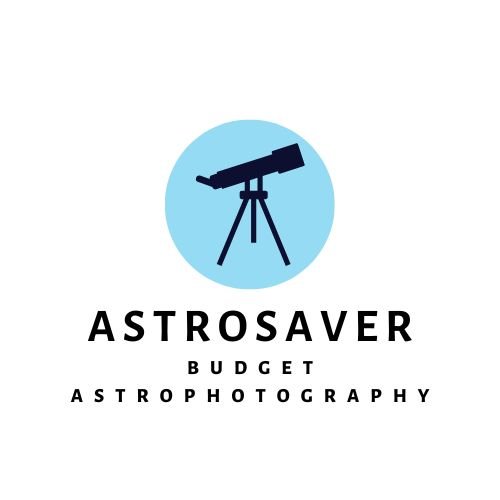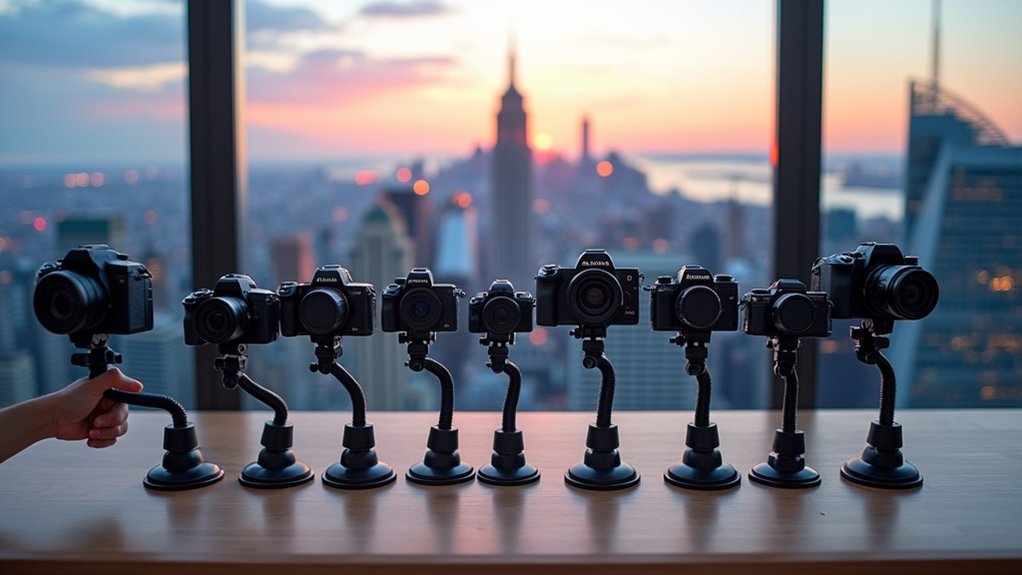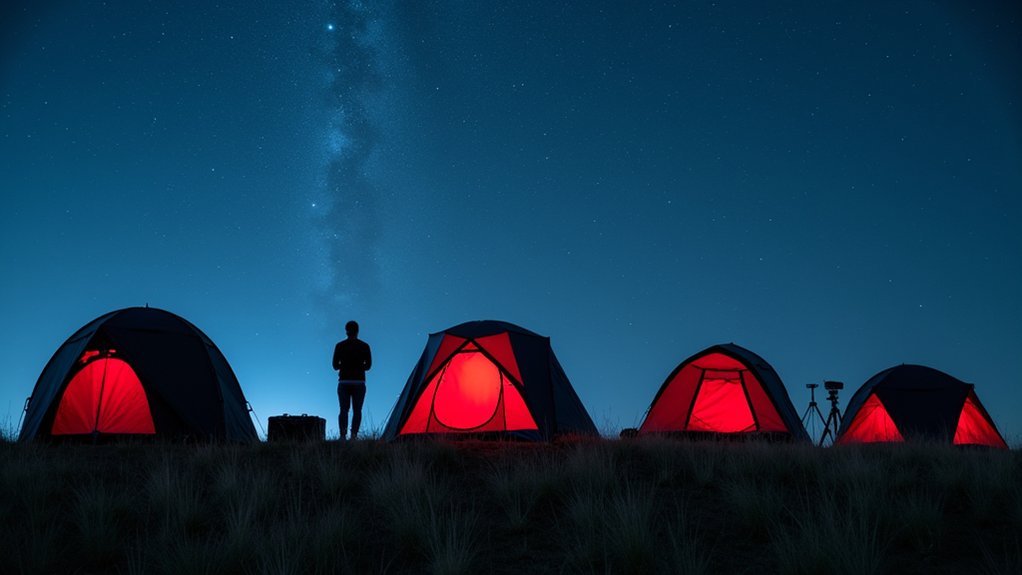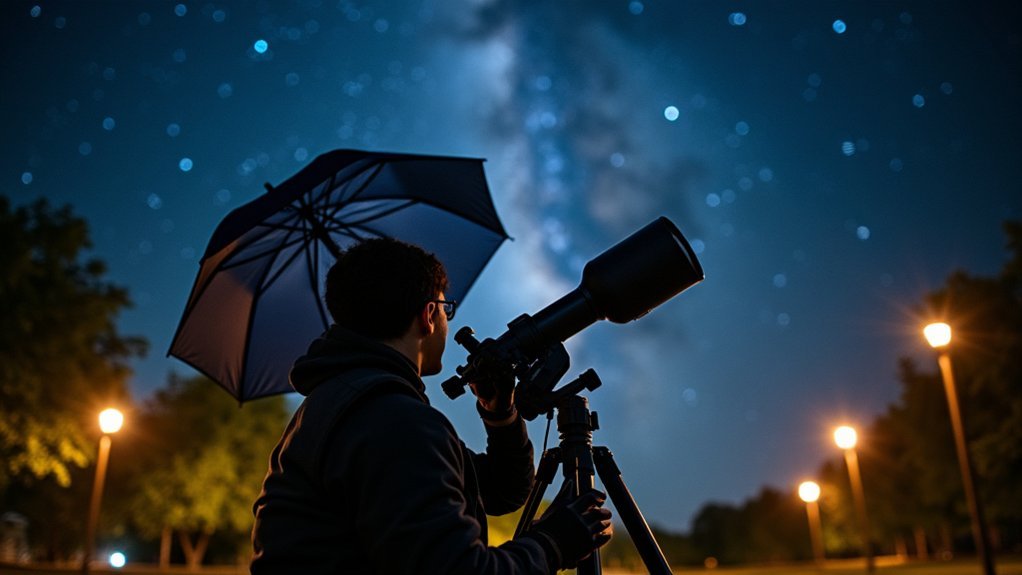To test your barn door tracker, check its polar alignment accuracy using the star drift method, verify tracking rates with timed exposures, test motor consistency, compare star trails between tracked/untracked images, assess mechanical stability, determine weight capacity limits, analyze battery life, evaluate environmental resilience, measure vibration dampening, and verify tracking at different focal lengths. These ten methods will help you diagnose issues and optimize your astrophotography setup for capturing the night sky with crystal-clear precision.
10 Ways To Test Your Barn Door Tracker
Once you’ve built your barn door tracker, you’ll need to verify its accuracy before attempting serious astrophotography.
Find a dark location with minimal light pollution and set up your equipment carefully.
Start testing with a wide-angle lens, capturing images at various exposure times: 30 seconds, 1 minute, and 2 minutes.
Examine each photo for star trails or blurring, which indicate tracking issues. If stars appear as streaks rather than points, your tracker needs adjustment.
Fine-tune your stepper motor’s rotation speed until it closely matches Earth’s sidereal rate of approximately 0.25 degrees per minute.
Document the maximum exposure time you can achieve without visible star trails for different focal lengths.
This methodical testing approach will help you optimize your barn door tracker for stellar results.
Polar Alignment Accuracy Test
To determine your barn door tracker’s polar alignment accuracy, you’ll need to test it using the star drift method, which reveals any east-west or north-south misalignments through extended observation.
You can easily verify your initial setup by using a protractor to confirm the hinge angle precisely matches your local latitude before beginning your observation session.
These accuracy checks will greatly improve your astrophotography results by ensuring stars remain pinpoint rather than creating unwanted trails during longer exposures.
Star Drift Method
While visual polar alignment might seem sufficient, the Star Drift Method provides a definitive test of your barn door tracker’s accuracy. This technique involves monitoring a bright star near the celestial equator during an extended exposure of at least 5 minutes without making any tracking adjustments.
Examine your final image carefully. If you see a point of light, congratulations—your polar alignment is spot-on. However, if you notice star trails forming a line, your tracker isn’t perfectly aligned with Earth’s rotation axis. The length and direction of these trails offer valuable clues about necessary adjustments to your polar alignment.
This method is particularly revealing when using longer focal lengths, which magnify even minor tracking errors. By analyzing the star drift pattern, you’ll gain precise insights into how well your barn door tracker is performing.
Protractor Alignment Check
Beyond watching for star drift, a more proactive approach involves using a protractor to verify your tracker’s alignment before you even begin shooting.
Set your protractor against the hinge, measuring the angle between it and the horizontal plane—this should match your local latitude exactly.
Ensure the hinge pin points toward Polaris, which is essential for proper celestial tracking. After setting the correct angle, look through your tracker’s viewfinder or alignment hole to confirm Polaris remains centered. This precise positioning prevents unwanted star trails in your final images.
Take a test exposure after completing these adjustments. If stars appear as sharp points rather than trails, you’ve achieved proper alignment.
This quick verification saves you valuable dark sky time and helps avoid disappointing results later.
Tracking Rate Verification
After completing your barn door tracker’s assembly, you’ll need to verify it’s actually moving at the correct rate to match Earth’s rotation.
The ideal tracking rate is 0.2507° per minute, which translates to approximately 1.195mm of travel per thread on your drive bolt.
Set up a simple test by measuring the actual angle change using a protractor over a specific time period. Your goal is to match the calculated rate precisely.
Most setups use stepper motors rotating at about one revolution per minute for best tracking.
The ultimate test comes from taking long exposure photographs.
Examine your images for star trails—minimal trailing indicates successful tracking.
Remember that longer focal lengths are less forgiving, requiring more precise tracking rate adjustments during extended exposures.
Motor Speed Consistency Check
Once your tracker is assembled, you’ll need to verify that your motor maintains consistent speed throughout operation. Use a stopwatch to time a complete revolution of your motor, aiming for exactly 1 RPM for accurate tracking.
Calculate the actual RPM by dividing revolutions by minutes, and check that your threaded rod advances at the correct rate to match Earth’s rotation of 0.25 degrees per minute. For stepper motors, verify each step produces the expected 1.8-degree movement.
The perfect star tracker demands precision: 0.25°/minute movement exactly mirrors Earth’s rotation, with each 1.8° stepper motor step precisely calibrated.
Test the motor at various intervals to identify any speed fluctuations that could affect long-exposure photos. Record your measurements and compare them to your theoretical calculations based on your threaded rod’s pitch.
Even minor inconsistencies can lead to star trailing when photographing the night sky.
Star Trail Comparison Method

You’ll immediately notice the difference between tracked and untracked images when comparing star trails side-by-side at identical exposure times.
Set up your camera to photograph the same celestial object twice—once with tracking engaged and once without—using matching settings like ISO 1600 for 4 minutes.
The tracked image should show pinpoint stars or neat circular trails around Polaris, while the untracked version will display elongated streaks, confirming your tracker’s precision.
Before/After Trail Analysis
One of the most revealing tests for your barn door tracker involves comparing star trails with the device both on and off. Take a series of long exposure shots (30 seconds or longer) with identical settings in both tracking and non-tracking modes.
Using focal lengths between 50-200mm will produce the clearest comparison results.
- Guarantee consistent exposure settings across all test images for accurate analysis
- Capture multiple frames in each mode to establish a reliable pattern
- Stack your images using Deep Sky Stacker to enhance trail visibility
- Look for round, dot-like stars in tracked images versus elongated streaks in untracked ones
This analysis directly demonstrates your tracker’s effectiveness—well-tracked stars appear as sharp points rather than trails, confirming your device is countering Earth’s rotation properly.
Tracking Precision Verification
While visual inspection provides initial feedback, quantifying your barn door tracker’s precision requires methodical comparison between tracked and untracked images.
Set up identical exposure parameters—ideally around 4 minutes—and capture two shots of the same celestial region, one with tracking engaged and one without.
A properly functioning tracker should produce markedly sharper stars with minimal elongation compared to the distinct trails in the untracked image.
Record your tracking rate (aim for the sidereal rate of 0.25 degrees per minute) and document the position of your hinge pin relative to the north celestial pole.
For detailed analysis, import both images into Deep Sky Stacker to evaluate star shapes quantitatively.
The difference in star definition between the two images directly reflects your tracker’s precision and accuracy of polar alignment.
Exposure Time Comparison
To properly assess your barn door tracker’s performance limits, establish a methodical series of test exposures at progressive durations.
Compare tracked and untracked images side by side to quantify your device’s effectiveness at preventing star trails.
- Set up identical test shots at 10, 20, 30, and 60-second exposure times while maintaining consistent ISO and aperture settings.
- Measure the angular elongation of stars in degrees to determine tracking accuracy.
- Document the maximum exposure time before noticeable trailing occurs.
- Use software like Deep Sky Stacker to analyze star shapes and point spread functions.
This comparison method provides concrete evidence of your tracker’s capabilities.
You’ll quickly identify the sweet spot where your images maintain pinpoint stars versus when they begin to show elongation, helping you optimize settings for future astrophotography sessions.
Long Exposure Performance Evaluation

After you’ve assembled your barn door tracker, evaluating its long exposure performance becomes critical for astrophotography success.
Begin by capturing a series of test images at 30, 60, and 120 seconds with your camera set to a high ISO (2000-3200). Examine each image carefully for star trails, which indicate tracking inaccuracies that become more pronounced in longer exposures.
Testing exposures at 30-120 seconds reveals tracking flaws that might ruin your astrophotography before they become catastrophic.
Compare photos taken with and without your tracker to measure its effectiveness. Look specifically at star shapes—pinpoint stars demonstrate proper tracking, while elongated ones reveal adjustments needed in alignment or motor speed.
For a thorough assessment, try stacking multiple short exposures using Deep Sky Stacker, which helps evaluate tracking consistency over time while producing higher quality final images than single long exposures can achieve.
Mechanical Stability Assessment
Before capturing deep sky images, you’ll need to thoroughly evaluate your barn door tracker’s mechanical stability, as this forms the foundation for all tracking performance. Verify the hinge mount is firmly secured and all connections are tight to prevent wobbling that can ruin your exposures.
- Place a level on the base to confirm perfect horizontal alignment before any tracking test begins.
- Test the hinge by opening and closing the plates, verifying smooth movement without binding or friction.
- Check that the rod is properly aligned and securely fastened at both connection points.
- Apply gentle taps to the tracker during operation to identify potential resonances or vibration issues.
Monitor your stepper motor’s torque during testing to verify it maintains consistent power throughout the tracking session, especially with heavier camera setups.
Weight Capacity Testing

With your tracker’s mechanical stability confirmed, the next challenge involves determining exactly how much weight your barn door tracker can reliably support.
Begin by mounting lightweight equipment first, gradually increasing the load while monitoring the tracker’s performance.
Use a digital scale to measure your camera gear’s total weight, ensuring you stay within your tracker’s weight capacity limits.
As you add equipment, watch carefully for any material flexing or hinge misalignment that could compromise tracking accuracy.
Document your results by taking test exposures at different weight points.
Compare these images to identify when performance begins to degrade.
If your tracker struggles with heavier loads, consider reinforcing the structure or upgrading to a more powerful motor.
A sturdy mount is essential—even the best tracker will fail if it can’t properly support your equipment.
Battery Life and Power Consumption Analysis
You’ll need to conduct thorough battery life tests by running your tracker under typical conditions, measuring voltage drops with a multimeter, and calculating total operational time based on your motor’s amp draw.
To enhance power consumption, consider implementing sleep modes during idle periods, using a more efficient motor driver, or upgrading to lithium polymer batteries that offer superior energy density.
The runtime comparison chart below illustrates the expected battery life across different power sources, helping you select the best configuration for your specific tracking needs.
Battery Life Test Methods
Evaluating your tracker’s battery performance thoroughly is crucial for reliable astrophotography sessions that won’t be cut short by power failure.
To properly assess your barn door tracker’s battery life, conduct testing under real-world conditions with your typical tracking rate.
- Run a full-charge endurance test, aiming for a minimum four-hour runtime to guarantee adequate coverage for most astrophotography sessions.
- Use a multimeter to measure the stepper motor’s current draw, helping you calculate expected operational time based on your battery’s capacity.
- Test in various temperatures, as cold conditions can greatly reduce battery performance and affect your tracking stability.
- Record the number of stepper motor steps during different sessions to establish correlations between movement patterns and power consumption.
Consider upgrading to higher-capacity lithium-ion batteries if your tests show insufficient runtime for your needs.
Power-Saving Optimization Techniques
Once you’ve established your barn door tracker’s battery performance baseline, it’s time to implement power-saving strategies that extend your shooting time. Choose a stepper motor with a lower voltage rating to reduce power consumption without compromising tracking accuracy.
| Technique | Power Savings | Implementation Difficulty |
|---|---|---|
| Sleep Mode | High | Medium |
| PWM Control | Medium | High |
| Low-Voltage Motor | Medium | Low |
| Lithium-Ion Batteries | High | Low |
| Current Monitoring | Variable | Medium |
Implement sleep mode in your control circuits to prevent energy waste when the tracker isn’t moving. Using PWM control methods allows your stepper motor to operate with just enough power for each tracking movement. For the best results, measure your motor’s current draw with a multimeter to identify power-saving optimization opportunities. Switch to rechargeable lithium-ion batteries for higher energy density and longer life between charges.
Runtime Comparison Chart
Three essential variables determine how long your barn door tracker will operate in the field: battery capacity, motor efficiency, and controller design.
To accurately analyze your motor-driven tracker’s performance, create a runtime comparison chart that documents voltage levels, current draw in mA, and operational time.
- Measure your NiCd battery’s performance by tracking voltage drop over several hours of continuous operation.
- Record the current consumption of your tracker at different exposure settings.
- Compare performance between different power sources (NiCd vs. Li-ion batteries).
- Calculate runtime expectations by dividing your battery’s mAh rating by your motor’s measured current draw.
Your runtime comparison chart provides vital data for field sessions, helping you avoid unexpected power failures during long exposure astrophotography.
Test under actual shooting conditions for the most accurate predictions.
Environmental Condition Resilience
While your barn door tracker may perform perfectly during initial tests, its true reliability emerges when faced with varying environmental challenges.
To guarantee ideal environmental condition resilience, test your tracker across different temperature ranges and humidity levels to identify any performance issues before your actual stargazing session.
Wind poses a significant threat to tracking accuracy, so secure your setup thoroughly and test it during breezy conditions.
For meaningful performance evaluation, choose clear nights with minimal light pollution. Consider testing at higher elevations where atmospheric interference is reduced.
Don’t overlook material durability—exposure to moisture can damage components over time.
Apply appropriate sealants to protect sensitive parts and conduct tests after light rain to verify your tracker’s weather resistance capabilities.
Frequently Asked Questions
How Do I Troubleshoot if My Stars Appear Elongated?
If your stars appear elongated, check your tracker’s alignment with Polaris, adjust the tracking rate, guarantee your mount is stable, and try shorter exposures. You’re probably experiencing tracking errors.
Can I Test My Tracker During Daytime?
Yes, you can test your tracker during daytime by aiming at distant objects. Track a far-away tree or building and see if it stays centered in your viewfinder while the tracker operates.
What Focal Lengths Work Best for Initial Testing?
For initial testing, you’ll get the best results with shorter focal lengths around 18-35mm. They’re more forgiving of tracking errors and will show you if your tracker’s working before you try longer lenses.
How Often Should I Recalibrate During an Imaging Session?
You should recalibrate your tracker every 10-15 minutes during an imaging session. Watch for star trailing in test shots and recalibrate immediately if you notice any drift becoming visible.
Will Temperature Changes Affect My Tracker’s Accuracy?
Yes, temperature changes will affect your tracker’s accuracy. As materials expand or contract with temperature shifts, you’ll need to recalibrate more frequently during nights with significant temperature fluctuations to maintain precise tracking.
In Summary
You’ve now got ten effective methods to evaluate your barn door tracker’s performance. By testing polar alignment, tracking accuracy, motor consistency, mechanical stability, and load capacity, you’ll guarantee peak astrophotography results. Don’t forget to check battery performance and environmental resilience too. Regular testing prevents frustrating field issues and helps you capture those spectacular night sky images you’re after. Make these checks part of your routine for consistently impressive results.





Leave a Reply